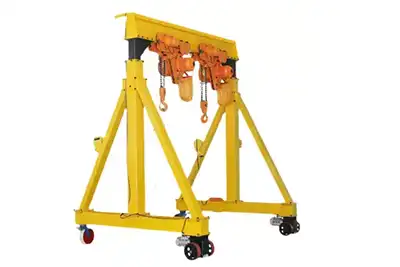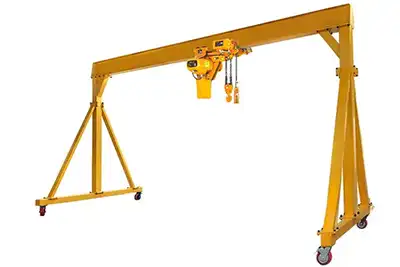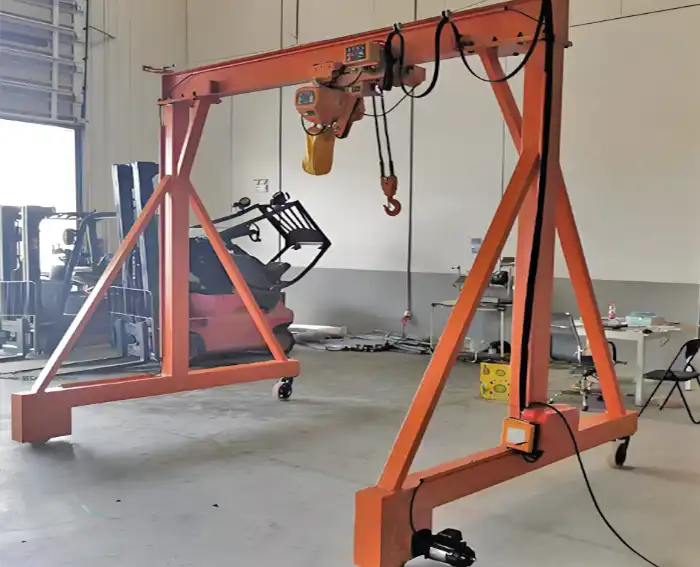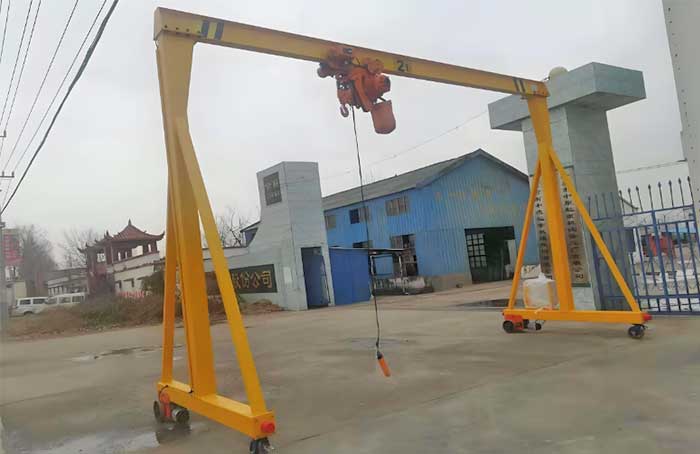Low Profile Gantry Cranes 1, 2, 3, and 5 Ton for Limited Spaces
Definition and General Features Low profile gantry cranes are specialized lifting devices designed to operate efficiently in areas with limited headroom. Unlike traditional gantry cranes, these cranes feature a compact design that allows them to fit into tighter spaces while still providing robust lifting capabilities. Key components include a low headroom electric hoist, which minimizes the distance between the crane's hook and the top of the crane structure, maximizing vertical lifting space. These cranes can rotate 360 degrees on the ground, providing exceptional maneuverability and flexibility in constrained environments.
Importance in Workshops with Height Constraints In workshops where vertical space is at a premium, low profile gantry cranes are invaluable. Traditional cranes often require significant headroom to operate effectively, which can be a major limitation in facilities with low ceilings. Low profile gantry cranes overcome this challenge by providing powerful lifting solutions that fit into restricted spaces without sacrificing performance. This makes them ideal for a variety of applications, from small automotive workshops to larger manufacturing plants where maximizing available space is crucial for operational efficiency.
To Highlight the Benefits and Applications of Low Profile Gantry Cranes with Varying Capacities This article aims to explore the advantages and uses of low profile gantry cranes with different load capacities, including 1 ton, 2 ton, 3 ton, and 5 ton models. By understanding the specific benefits and practical applications of each capacity, businesses can make informed decisions about which crane best meets their needs. From improving workflow in limited spaces to ensuring safe and efficient material handling, low profile gantry cranes offer versatile solutions tailored to various industrial requirements.

Low profile portable gantry crane with motorized travelling design

Low profile portable gantry crane with manual travelling design
Basics of Low Profile Gantry Cranes
Design and Structure
Key Components Low profile gantry cranes are engineered with a focus on maximizing utility in confined spaces. The primary components include:
- Frame: A robust and stable structure that supports the entire crane system. It's designed to withstand heavy loads while maintaining stability.
- Legs: The legs provide the necessary support and are typically equipped with wheels or casters for easy movement.
- Beam: The horizontal beam spans the width of the crane and supports the hoist and load. It's designed to offer maximum lifting height within limited vertical space.
- Hoist: The lifting mechanism, usually an electric hoist, which is responsible for raising and lowering loads.
- Wheels or Casters: These allow the crane to move smoothly across the workshop floor, enhancing its mobility and versatility.
Low Headroom Electric Hoists
The low headroom electric hoist is a critical component that sets these cranes apart. Unlike standard hoists, low headroom hoists are designed to minimize the distance between the load hook and the beam, thereby maximizing the available lifting height. This design is particularly advantageous in workshops with limited ceiling heights, as it ensures that even in tight vertical spaces, the crane can still lift objects efficiently. These hoists are typically compact, yet powerful, capable of handling significant loads while fitting within the constrained dimensions of low profile gantry cranes.
Advantages of Low Profile Design
Space Efficiency Low profile gantry cranes are specifically designed to operate in environments where space is limited. Their compact structure means they can fit into workshops with low ceilings or restricted vertical clearance. This space efficiency allows businesses to utilize more of their available area for productive activities, rather than being limited by the spatial requirements of traditional cranes. By optimizing the use of space, these cranes enable more effective and efficient workflow, even in confined environments.
Enhanced Maneuverability One of the standout features of low profile gantry cranes is their exceptional maneuverability. Equipped with wheels or casters, these cranes can be easily moved around the workshop floor. This 360-degree mobility ensures that the crane can reach different areas without the need for additional infrastructure, such as tracks or fixed support beams. The ability to reposition the crane as needed provides significant flexibility, allowing operators to handle various tasks and materials with ease. This enhanced maneuverability not only improves operational efficiency but also reduces the time and effort required for material handling tasks.
Capacity Options and Their Applications
1 Ton Gantry Cranes
Ideal Uses and Common Applications 1-ton gantry cranes are perfect for light-duty tasks where precision and maneuverability are essential. They are commonly used for lifting small parts and components in workshops and warehouses. These cranes are ideal for applications such as:
- Assembling small machinery
- Handling light raw materials
- Moving small pallets or containers
Specific Industries Benefiting from 1-Ton Capacity Industries that frequently utilize 1-ton gantry cranes include:
- Automotive repair shops: For lifting engines and vehicle parts.
- Small manufacturing units: For handling lightweight production materials.
- Warehouses: For organizing and moving inventory efficiently.
2 Ton Gantry Cranes
Typical Scenarios and Material Handling Tasks 2-ton gantry cranes are suitable for medium-duty tasks that require a balance between load capacity and operational flexibility. Typical scenarios where these cranes are used include:
- Handling slightly heavier machinery and equipment
- Moving bulkier raw materials
- Assisting in moderate-scale assembly processes
Case Studies of 2-Ton Crane Usage
- Case Study 1: Medium-Sized Manufacturing Plant In a mid-sized manufacturing plant, a 2-ton gantry crane was used to streamline the production process. The crane efficiently moved materials between different workstations, significantly reducing manual handling and improving overall productivity.
- Case Study 2: Construction Site On a construction site, a 2-ton gantry crane facilitated the lifting and positioning of construction materials, enhancing safety and operational efficiency by reducing the need for manual labor.
3 Ton Gantry Cranes
Situations Requiring 3-Ton Capacity 3-ton gantry cranes are designed for heavier tasks that still demand a degree of mobility and versatility. Situations where a 3-ton capacity is essential include:
- Lifting and moving large machinery components
- Handling heavier raw materials in manufacturing processes
- Supporting maintenance tasks for larger equipment
Efficiency Improvements in Medium-Duty Tasks In scenarios requiring medium-duty lifting, 3-ton gantry cranes offer significant efficiency improvements. They allow for quicker, safer, and more precise handling of materials, reducing downtime and increasing productivity. For instance, in a repair shop, a 3-ton crane can lift and transport large parts more effectively than multiple workers, enhancing overall workflow.
5 Ton Gantry Cranes
Heavy-Duty Applications and Industrial Usage 5-ton gantry cranes are built for heavy-duty applications where substantial lifting power is required. These cranes are commonly used in:
- Heavy manufacturing industries: For moving large, heavy components.
- Shipyards: For handling ship parts and large equipment.
- Large-scale construction projects: For lifting and positioning heavy materials.
Examples of Industries and Tasks for 5-Ton Cranes
- Manufacturing Plants: 5-ton cranes are used to handle heavy machinery and large-scale production materials, ensuring efficient and safe operations.
- Shipbuilding: These cranes assist in the assembly and maintenance of ships by lifting substantial components and equipment.
- Construction: On construction sites, 5-ton gantry cranes are indispensable for moving heavy structural elements, reducing the need for manual labor and enhancing site safety.
By understanding the specific uses and benefits of each capacity option, businesses can select the appropriate low profile gantry crane to meet their operational needs, ensuring efficiency and productivity even in space-constrained environments.

Installation and Operational Benefits
Ease of Installation
No Need for Tracks or Steel Beams One of the most significant advantages of low profile gantry cranes is their ease of installation. Unlike traditional cranes, which often require extensive infrastructure such as tracks or overhead steel beams, low profile gantry cranes can be set up directly on the workshop floor. This simplicity eliminates the need for complex and costly installations, making these cranes an excellent choice for businesses looking to minimize setup expenses and time.
Quick Setup and Minimal Disruption The straightforward design of low profile gantry cranes ensures a quick and hassle-free setup. Since these cranes do not require permanent fixtures, they can be installed and operational in a short period. This rapid deployment means minimal disruption to ongoing operations, allowing businesses to continue their activities with little to no downtime. Furthermore, the portability of these cranes means they can be easily relocated or adjusted as the layout of the workshop changes, providing a flexible solution that adapts to evolving needs.
Operational Flexibility
360-Degree Rotation Capability Low profile gantry cranes are designed with exceptional maneuverability in mind. Equipped with wheels or casters, these cranes can rotate 360 degrees, allowing for complete operational flexibility. This feature is particularly beneficial in tight or confined spaces where traditional cranes might struggle to reach certain areas. The ability to move and position the crane precisely where it's needed enhances efficiency and reduces the time and effort required for material handling tasks.
Versatility in Different Workshop Layouts The versatility of low profile gantry cranes extends beyond their maneuverability. These cranes can be easily integrated into various workshop layouts, from small, crowded spaces to larger, open areas. Their design allows them to navigate around obstacles and reach different parts of the workshop without the need for additional infrastructure or modifications. This adaptability makes them suitable for a wide range of applications, from small-scale repair shops to large manufacturing plants, providing a flexible lifting solution that can meet diverse operational requirements.
By offering ease of installation and exceptional operational flexibility, low profile gantry cranes help businesses maximize their workspace and improve overall efficiency. These benefits make them an invaluable asset for any workshop or facility facing height constraints and needing a versatile, efficient lifting solution.
Safety and Maintenance
Safety Features
Built-in Safety Mechanisms Low profile gantry cranes are equipped with a range of built-in safety mechanisms designed to ensure safe operation and protect both operators and materials. These features typically include:
- Overload Protection: Prevents the crane from lifting loads beyond its rated capacity, reducing the risk of accidents and equipment damage.
- Emergency Stop Buttons: Allows operators to quickly halt the crane's operation in case of an emergency.
- Safety Locks: Secures the crane and load in position, preventing unintended movement.
- Warning Alarms and Indicators: Alerts operators to potential issues, such as overloading or system malfunctions, ensuring timely intervention.
Compliance with Industry Standards To ensure maximum safety, low profile gantry cranes are designed and manufactured in compliance with relevant industry standards and regulations. These standards cover various aspects, including design, construction, testing, and operation, ensuring that the cranes meet the highest safety requirements. Compliance with industry standards not only enhances safety but also provides peace of mind to businesses, knowing that their equipment is built to rigorous specifications.
Maintenance Tips
Routine Checks and Servicing Regular maintenance is crucial for the safe and efficient operation of low profile gantry cranes. Routine checks and servicing help identify potential issues before they become major problems. Key maintenance activities include:
- Inspection of Mechanical Components: Regularly check the crane’s frame, hoist, and wheels for signs of wear and tear or damage.
- Lubrication of Moving Parts: Ensure all moving parts are properly lubricated to reduce friction and prevent premature wear.
- Testing Safety Mechanisms: Periodically test all safety features, such as overload protection and emergency stop buttons, to ensure they function correctly.
Prolonging the Lifespan of Gantry Cranes Implementing a thorough maintenance program can significantly prolong the lifespan of low profile gantry cranes. Tips for extending the crane’s life include:
- Adherence to Manufacturer’s Guidelines: Follow the maintenance and operation guidelines provided by the crane’s manufacturer.
- Scheduled Servicing: Establish a regular servicing schedule with qualified technicians to perform detailed inspections and repairs.
- Proper Training for Operators: Ensure that all crane operators are properly trained in the correct use and maintenance of the equipment.
- Record Keeping: Maintain detailed records of all inspections, maintenance activities, and repairs to track the crane’s condition over time and anticipate future maintenance needs.
By incorporating robust safety features and adhering to diligent maintenance practices, businesses can ensure the safe and efficient operation of low profile gantry cranes, maximizing their utility and lifespan while minimizing the risk of accidents and downtime.
Customized Low Profile Gantry Crane for Your Needs
Low profile gantry cranes offer a versatile and efficient solution for workshops with limited height. Their compact design, coupled with powerful lifting capabilities, makes them ideal for various applications. Key benefits include:
- Space Efficiency: Maximizing usable space in height-constrained environments.
- Maneuverability: 360-degree rotation and easy movement enhance operational flexibility.
- Ease of Installation: Quick setup without the need for tracks or steel beams, minimizing disruption.
- Safety and Maintenance: Built-in safety features and routine maintenance ensure safe and reliable operation.
Selecting the right capacity for specific needs is crucial to maximizing the efficiency and safety of material handling operations. Whether it's a 1-ton crane for light tasks or a 5-ton crane for heavy-duty applications, understanding the unique requirements of your workshop will help you make the best choice.
Low profile gantry cranes are an excellent investment for businesses facing height constraints. Their ability to perform efficiently in confined spaces, coupled with ease of installation and operational flexibility, makes them indispensable in various industrial settings. By considering low profile gantry cranes, you can enhance productivity, safety, and overall workflow in your limited-height workshop.



 Low profile portable gantry crane with motorized travelling design
Low profile portable gantry crane with motorized travelling design Low profile portable gantry crane with manual travelling design
Low profile portable gantry crane with manual travelling design